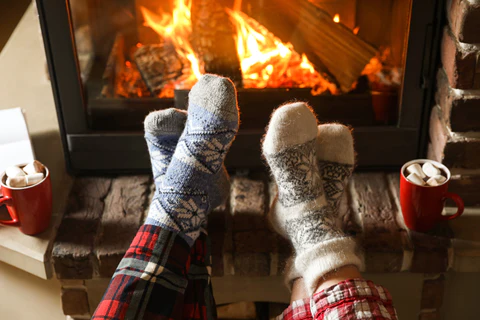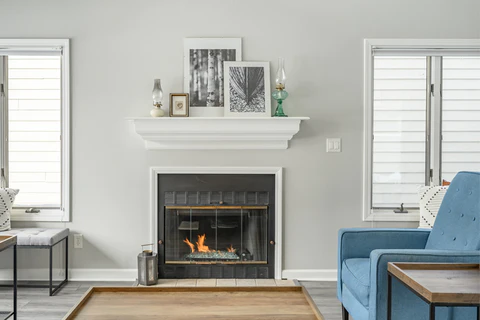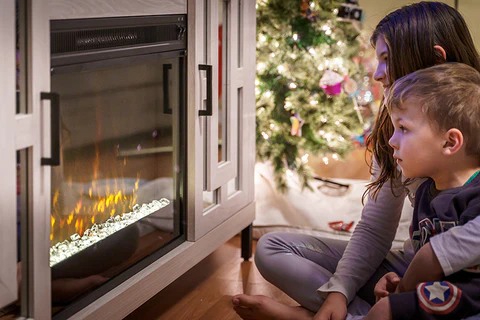How To Clean Your Fireplace
Often the focal point of a room, a crackling fire adds warmth, ambiance, and style to a home.
Fireplaces require regular cleaning both for appearances and safety. With every fire, ash, soot, creosote, and other debris collect inside your fireplace, and over time, this buildup can pose a dangerous fire hazard. Neglecting regular fireplace cleaning can also result in dark stains around the hearth and mantel or cause fine ash and dust to spread throughout your home’s air.
By learning how to clean a fireplace the right way, you can reduce dust and particulates in the air, lessen smoky odors, and reduce the chance of accidental fire damage. To thoroughly clean your fireplace, follow the steps below. When you’re done, you’ll be ready to snuggle up around the fire.

Wood-Burning Fireplaces
Wait 24 hours after your last fire before cleaning a fireplace to ensure it’s completely cool. This task will likely get messy, so plan to wear old clothing, and take precautions to avoid inhaling soot and ash. Wear safety goggles, gloves, and a dust mask or respirator.
Step 1: Remove Ash and Debris
Discard any remaining chunks of burnt wood. Remove the andirons and grate and set aside. Using a fireplace shovel scoop out ash and debris into a small, metal—never plastic—bucket. Dispose of them in a metal trash can or add the ashes to your garden soil to enrich it. Alternatively, use a handheld broom to sweep ash from the walls and floor of the fireplace into a dustpan and discard.
Remove the remaining dust on the walls and floor with a shop vacuum or the hose attachment of your regular vacuum. This is also a good time to vacuum and dust the hearth, fireplace surround, and mantel.
Step 2: Deep-Clean the Firebox and Surround
- Fill a spray bottle with cool water and two buckets with one gallon of warm water each. To the first bucket, add two tablespoons of grease-cutting dishwashing liquid. To the second bucket, add one cup of distilled white vinegar.
- Spray a small area of the firebox with water. Dip a stiff-bristled scrub brush in the soapy solution and sprinkle it with regular table salt. The abrasive salt will help loosen the soot.
- Scrub the dampened area and use a sponge to wipe away the soot. Dip a second sponge in the vinegar solution and rinse the cleaned area. The vinegar helps cut through any remaining residue and reduces smoky odors.
- Continue scrubbing, rinsing out the brush and sponges often, until the firebox is clean. If the fireplace is large, you may need to mix a second batch of fresh cleaning solutions.
Step 3: Clean the Fireplace Doors
Fireplace glass can get pretty filthy over the winter months. Naturally, you don’t want that layer of grime hanging out all year long. Leftover ash can serve as a mild, natural abrasive for cleaning fireplace doors. Dip a damp paper towel into your bucket of ash and scrub the doors until clean. You’re going to need to put some muscle behind this to see results. Once all the grime is gone, wipe off any streaks with a dry microfiber cloth.
Step 4: Clean the Andirons and Grates
Wash the andirons, grates, and other fireplace tools with dish soap and water. To avoid making a mess indoors, consider cleaning fireplace accessories outside. Use a stiff-bristled brush to scrub any stubborn stains. Rinse and let dry before replacing the andirons and grates inside the fireplace.
When to Call a Professional
If you prefer to leave the messy job of inspecting and cleaning your fireplace or stove to someone else, expect to pay $100-$200 for a professional inspection and cleaning. Although the chimney sweep industry is not regulated or licensed by a government agency, many sweeps apply for certification by the Chimney Safety Institute of America (CSIA) or membership in the National Chimney Sweep Guild (NCSG). These organizations promote professionalism in the industry by testing applicants and providing continuing education opportunities to keep members up-to-date on current technology and fire safety.
- Removing Creosote Buildup: Having your chimney professionally cleaned is often the best way to remove creosote. When wood burns, it produces water vapor, gases, and smoke. Ideally, all these are swept up the flue and out the chimney. However, as these warm vapors reach the upper parts of the chimney, they encounter the cooler outdoor air and condense, forming creosote. This black or brown residue clings to the inner surfaces of the flue liner and can be hard and glassy, sticky, or even dry and flaky.
- Cleaning the Chimney and Flue: If you can’t see the entire flue from below, you’ll have to check from the roof. If you’re at all uncomfortable doing this or have no experience working on a roof, hire a professional chimney sweep to inspect and clean the chimney and the flue.

Gas Fireplaces
While frequently used wood-burning fireplaces require more maintenance, even gas-powered fireplaces should be cleaned regularly. Turn off the gas at the main valve and vacuum away dust and cobwebs from the firebox. Inspect the unit for any cracks or scorched areas and call a certified gas technician if you see problems.

Electric Fireplaces
Electric fireplaces are cleaner than gas or wood fireplaces since they warm the air with a heater. However, they require cleaning, just like any other aspect of the house. By now, we know an essential step is to turn off the unit. Open or remove glass doors. With a clean cloth, dust your hearth, andirons, logs, and stones. To make your metal andirons even shinier, use metal polish. Use a hand vacuum or hose attachment to clean vents.
The interior and exterior of your fireplace walls should be cleaned with a duster or a damp, clean cloth. Your fireplace’s glass doors should be cleaned. Use a clean cloth or paper towels along with a plant based glass cleaner.
—–
Knowing how to clean a fireplace can make the idea of lighting that cozy fire a bit more enticing. So until the weather warms up, keep your hearth soot free and enjoy the crackling sounds of the fire that makes your home that much cozier.
